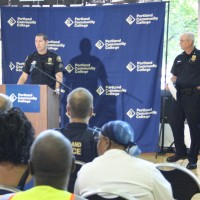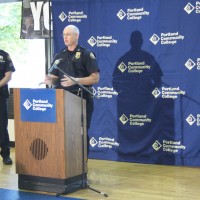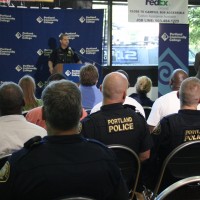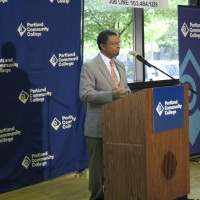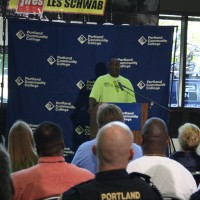This content was published: August 21, 2012. Phone numbers, email addresses, and other information may have changed.
Press Conference Highlights Neighborhood Crime-Fighting Efforts around PCC Cascade Campus Pay Off
Photos and Story by Abe Proctor
For years, the area around the Cascade Campus – particularly in the vicinity of the intersection of North Albina Avenue and Killingsworth Street – has had a reputation as a rough neighborhood. A new report released by the Portland Police Bureau, however, shows that this reputation may soon be a thing of the past.
“The North Albina and Killingsworth Collaboration”— officially released at an Aug. 16 press conference in the Cascade Gym — details the extraordinary progress made by the neighborhood in recent years to reduce street crime and other undesirable activity. The report largely attributes this progress to the work of the Albina-Killingsworth Safe Neighborhood Commission, a community safety group founded by Cascade Campus President Algie Gatewood in 2006, of which the Police Bureau is a member.
“By establishing new norms of accepted behavior, addressing criminal activity pro-actively both using enforcement and problem solving and helping to build the communities capability to resist criminal activity,” the report states, “the collaboration was able to decrease crime while progressively reducing the use of enforcement.”
According to the report, “Part I” crimes in the area –the bad ones: murder, aggravated assault, robbery, etc. – are down 27.4 percent from 2007 to 2011. From January 2011 through July 2012, Part I crimes in the area are down by 16.1 percent, while at the same time, citywide Part I crimes rose by 9 percent.
Gatewood created the Albina-Killingsworth Safe Neighborhood Commission in 2006 to address the persistent street crime in the area around the Albina-Killingsworth intersection. Residents, students, workers and businesspeople alike shared a concern about repeated incidents of loitering, theft, drug possession and dealing graffiti and, sometimes, gang violence.
In the face of these problems, Gatewood reached out to the community and asked them to come together and find ways to make the neighborhood a safer and more livable place. He tapped local residents, business owners, the Police Bureau, Jefferson and Rosemary Anderson high schools, and representatives from government agencies in the area, such as the Multnomah County Library and TriMet. They began to meet regularly, and the Albina-Killingsworth Safe Neighborhood Commission was born.
“Since the Commission began, we have made tremendous strides toward making this a safer, warmer, and more welcoming neighborhood,” Gatewood said at the press conference. “The really wonderful thing about this is that much of our progress has come from simply getting to know one another better, meeting regularly, sharing information, and just knowing that we all have each other’s back.”
The Commission started out by coming up with common-sense approaches to the neighborhood’s crime troubles. For example, they increased the number of surveillance cameras along the Campus’ perimeter, and expanded this network to include new cameras on commercial buildings along North Killingsworth street. PCC Public Safety officers regularly share access to the camera network with the Police Bureau, and the surveillance footage has led directly to the apprehension of suspects.
Another example of the Commission’s work is “The Wall,” a short concrete retaining wall adjacent to a Campus parking lot. “The Wall” was a notorious hangout in the neighborhood that was a magnet for loitering, and a spot where drugs were frequently bought and sold. A public pay phone nearby provided a discreet link between dealers and customers.
In the spring of 2012, the Commission decided it was time to do something about “The Wall.” They installed a wrought-iron fence along its edge that transformed “The Wall” from an attractive spot to sit and hang out to a place where it was impossible to sit at all. The notorious pay phone was also removed, and almost overnight, “The Wall” ceased to be a problem.
But the Commission’s work really took off in 2011, after a conversation between Gatewood and Portland Police North Precinct Cmdr. Mike Leloff. Cmdr. Leloff, impressed with the Commission’s efforts, decided to step up the Police Bureau’s commitment to the neighborhood. A dedicated street crime unit was created, and hit the streets in late 2011.
The new unit quickly made its presence felt, and let it be known that they weren’t going anywhere. Enforcement was a priority at first, with “probable cause” arrests targeted at the problem behaviors targeted by the community – public drunkenness and minors in possession of alcohol, for example. After awhile, though, as the unit became a more familiar presence and the problem behaviors began to abate, enforcement took a back seat to efforts to establish and maintain relationships and partnerships with the community.
“At first we were spending time dealing with burglaries and assaults,” said Sgt. Mark Friedman, head of the street crime unit, said at the press conference. “Now we’re talking about safe pedestrian crossings. That’s progress.”
Going forward, the Commission and the Police Bureau are focusing on broadening and strengthening the relationships that have developed in the neighborhood, and continuing the area’s collaborative approach to collective safety. With a new positive attitude in the neighborhood, and with PCC’s bond-funded construction program on the horizon, Gatewood said that the future looks better than ever.
“Coming together as a community has improved our quality of life,” Gatewood said. “This is a warmer and more welcoming neighborhood, and I couldn’t be more proud.”
To view the Police Bureau’s report, “The North Albina and Killingsworth Collaboration,” visit http://www.flashalertnewswire.net/images/news/2012-08/3056/56843/Albina_Collaboration_Part_I_V4.pdf

